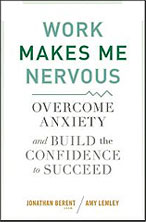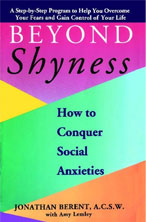Food for thought
Still Misunderstood and Often Underestimated,
Shyness remains anxiety disorder of the millennium.
According to the American Journal of Psychiatry, “If the 1980’s were considered to be the decade of anxiety, most would agree that panic disorder and obsessive compulsive disorder received the greatest attention. The 1990’s are sure to be another decade of anxiety, but we can expect other anxiety disorders to take the limelight, particularly social phobia (severe shyness).”
Millions of individuals suffer from this problem or other “hidden” social handicaps. They run the gamut in degrees of suffering.
The most common example is fear of public speaking, the number one phobia in this country. Also common, is uncontrollable anxiety surrounding interaction with an authority figure. Each can be stifling and often have serious ramifications. Consider, also, the following examples:
- Teenagers who develop school phobia because of underling social fears.
- Young adults who are pathologically over- dependent on their parents.
- Children who do not talk because of social anxiety (selective mutism).
- Individuals who are behaviorally paralyzed because of difficulty with social skills.
- Aspiring executives and professionals whose careers are stifled because of job related social anxiety.
- Married persons who are emotionally debilitated by social fears.
- Individuals whose only friends are their computers and televisions.
- Adults who are debilitated by panic and symptoms of blushing and sweating.
- Adults who never date and are involuntary virgins.
- Eating disorder sufferers whose problems stem from social anxiety.
Estimates range that from 3 to 12 percent of the overall population suffers from social phobia or extreme shyness. Most individuals who are affected never seek help because of fear of humiliation and embarrassment. For this reason, social phobics are very much an unstudied population. Those who do seek help often receive inappropriate or ineffective treatment. Most current treatment of social anxiety is based on medication. For many individuals this just breeds further dependence, which itself is a big part of the problem.
The by-products of social anxiety include depression; self medication, with alcohol usually the drug of choice; an inability to compete in today’s stressful society characterized by poor performance and a lack of productivity, and often family distress.
When people hear the word “shy,” they often think of children. The reality is that most people who seek help for this problem are adults. The common response to children with this problem is “They will grow out of it.” In cases where the problem is substantial, it worsens over time.
It is important to grasp some basic concepts about the two closely related dynamics of shyness and social anxiety: Both terms describe a learned response to social interaction. I refer to this fear response as interactive inhibition. When interactions are inhibited by social anxiety, a person is unable to get as much out of life as is possible. When individuals who have this problem think that “shyness” is an unchangeable personality trait, they are creating a major obstacle for themselves that stands in the way of fulfillment and productivity. The reality is that shyness is social anxiety. Social anxiety is a learned response and habit that can be broken. Furthermore, at the risk of being controversial, as an individual begins to understand that social anxiety is a combination of attitudinal, emotional. behavioral, and physical responses, it will be understood that there actually is no such thing as shyness. Rather what was understood as “shyness” is actually social anxiety, a psychophysiological response that can be learned to be controlled. In other words, it is a way of reacting, not an unchangeable instinct that has chosen the person in question.
Self-Help and Treatment Options
- Free Audio CD from Social-Anxiety.com
- Social Anxiety: The Untold Story
- Beyond Shyness: How To Conquer Social Anxieties
- Work Makes Me Nervous
- Comprehensive Self-Therapy Audio Program
- Public Speaking Anxiety Self-Therapy Audio Program
- “Warm Hands Cool Face” A Self-Help Clinical Program for Blushing Anxiety & Erythrophobia
- The Berent Method: High Performance Therapy for Social-Anxiety
- Telephone/skype therapy available worldwide
- Selective Mutism Seminar Audio CD/MP3 Program
- Self-Help Program for Parents of Children with Selective Mutism
- The Sociability Questionnaire
- Tip of the Month Club
- Social Therapy and The Learning Disabled
- Free Parent Addiction Survey


